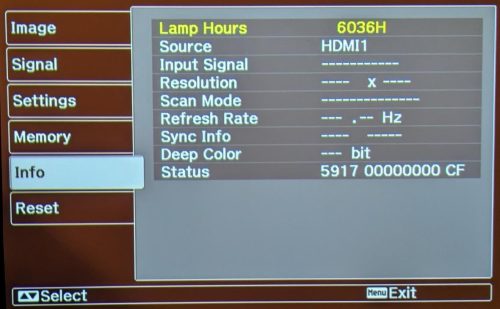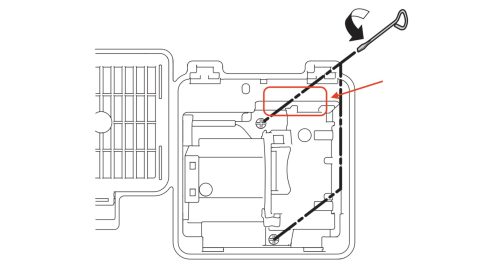 Way, way back in 2008 I purchased the Epson 1080UB. While I wasn’t new to having a home theater setup, this was my first step into digital projectors. I run the projector in ‘low brightness mode’ as I’ve got a dedicated room that has complete light control. This lets me extend the lifetime of the lamp, as per the manual you should get 3000 hours.
Way, way back in 2008 I purchased the Epson 1080UB. While I wasn’t new to having a home theater setup, this was my first step into digital projectors. I run the projector in ‘low brightness mode’ as I’ve got a dedicated room that has complete light control. This lets me extend the lifetime of the lamp, as per the manual you should get 3000 hours.
Lamp life: 2500 hours (in high brightness mode, for select color modes) to 3000 hours (in low brightness mode, for select color modes), depending on usage
Around the 3000 hour mark, the 1080UB will start to show you a warning on screen shortly after you power it on. This warning thankfully goes away after a short time, but it returns every power on.
 I’ve been living with the warning for some time (apparently years). As I understand it, the light output will drop over time. While human vision is quite adaptable, eventually you’ll get to a point where it’s obviously too dim. Honestly, this didn’t happen for me – my original bulb was still going strong. Still, this same one had been running since 2008, more than 15 years. It had also seriously exceeded the expected lifetime.
I’ve been living with the warning for some time (apparently years). As I understand it, the light output will drop over time. While human vision is quite adaptable, eventually you’ll get to a point where it’s obviously too dim. Honestly, this didn’t happen for me – my original bulb was still going strong. Still, this same one had been running since 2008, more than 15 years. It had also seriously exceeded the expected lifetime.
 During the Black Friday sales, I grabbed a deal on a new lamp. The Araca lamp for the Epson 1080UB wasn’t the cheapest option, but it had good reviews and it was one of the options I’d been watching for a while.
During the Black Friday sales, I grabbed a deal on a new lamp. The Araca lamp for the Epson 1080UB wasn’t the cheapest option, but it had good reviews and it was one of the options I’d been watching for a while.
6036 hours over 15 years is 251 days of display time. That’s an average of 16 days of viewing time every year. If I had exclusively watched movies that would be more than 2400. It is an impressive number no matter how you slice it up. While I’ve occasionally had the upgrade bug, there hasn’t been a good reason to retire the Epson 1080UB.
The new lamp arrived well boxed. It included a white cotton glove for handling it to help avoid transferring any oils from your skin to the lamp – any contaminants can cause early failure. The Epson 1080UB manual cover the replacement process (page 50). There was also a disposable Phillips screwdriver included, but I didn’t use it as it was terrible.
I took my projector down from the ceiling mount. Did a careful dusting, and cleaned out the filter. I then put on some nitrile gloves, then put on the (one) cotton glove on my dominant hand to handle the lamp.
Removing the lamp is straight-forward but after loosening the two screws I found the lamp was still fairly tightly connected to the projector. After a little fiddling around I discovered that it does take a pretty firm tug to lift the lamp out as it is seated in a power socket under the lamp.
 I’ve indicated the approximate location circled in red. Make sure the screws are fully loosened, then it should come out with a firm pull straight up. It did take a few tries, and more force than I anticipated. Once it unseats from the connector, it will lift out easily.
I’ve indicated the approximate location circled in red. Make sure the screws are fully loosened, then it should come out with a firm pull straight up. It did take a few tries, and more force than I anticipated. Once it unseats from the connector, it will lift out easily.
There was a tiny bit of dust in the lamp compartment that I wiped out with a dry dusting cloth. Installing the new lamp was uneventful. It required a firm push to fully seat. The new lamp fit perfectly.
After re-installing the projector, the new lamp started up without any drama. This new lamp may take a slightly bit longer to warm up than the original. The first thing I did was to reset the hour counter on the 1080UB as per the manual.
For the first hour or two there was a strong ‘new electronics’ smell, I left it running to let that clear out and to ‘burn’ the new lamp in. During this time I made sure the projector was well aligned, and focused on my screen. I left it running while we had dinner to let the smell work itself out. After dinner I turned it off and let it cool down for an hour or so.
Later, we all sat down to watch a movie. Again the power on warm up phase feels a bit slower to me than the original. I do think the overall light output is a bit brighter once it has reached operating temperature, but it is hard to say. The viewing experience isn’t that different. The smell is either very faint, or gone completely at this point. I’ve kept the original as a backup in case this one fails.







